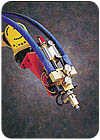
Traditionally, Ingersoll-Rand Dispense Systems (Rochester Hills, MI) has used a conventional flow meter in its mastic regulator units, which dispense adhesives and sealers for the purpose of bonding and sealing various automobile body panels. The regulator unit would be coupled to a flow meter on one side and a dispensing gun on the other side.
During operations, the material is conditioned to a constant temperature, within a tenth of a degree, to maintain a constant viscosity. Variable pressures are used to regulate material flow during actual dispensing. Flow rates need to be extremely precise to ensure materials are dispensed correctly. For example, on an automotive enclosure, the dispenser robot moves across the straight sections at its maximum speed. As the dispenser approaches a corner, it reduces the flow rate to avoid depositing excess adhesive.
However, the situation became more complicated when Ingersoll-Rand upgraded the system with a new two-part material dispenser. Among other goals, Ingersoll-Rand wanted to both produce a more accurate adhesive flow control, and provide a record of displacement and flow outputs while minimizing maintenance requirements for the dispensing unit. Precise flow control would be accomplished using a more capable servo air cylinder control and improved viscosity conditioning.
Unfortunately, the two-part adhesive makes it impractical to use the standard gear-type flow meter for monitoring, because it requires frequent cleaning and maintenance.
"The piston inside the air chamber has two rods, which pump the catalyst and resin. The two rods have different sizes, using a four to one ratio mix. When the command is given, the guns open both sides and the material is forced into a mixing chamber, then out of the tip and onto the car," says Joe Meloche, Ingersoll-Rand director of system services. "The material sets solid within 8 minutes of mixing, so you cannot put it through a flow meter and expect to clean it out on a daily basis. In trying to get as far as possible from any required maintenance of the equipment, we realized the optimum design would be with a non-contact transducer."
Ultimately, noncontact Temposonics R-series magnetostrictive position transducers from the Sensors Division of MTS Systems Corp. (Cary, NC) solved the problem. In the context of this dispensing application, the magnet is attached to the air cylinder piston, which is immediately below the transducer. As the piston moves up and down, it provides a snapshot of the volume at the beginning and end of the dispensing cycle. This, in turn, can be used to accurately determine dispensing volumes.
Because the MTS sensors are immune to electrical noise-which can be a serious problem in an automotive assembly environment-they succeeded in cutting down on process variability. Because of their precision, they make it possible for operators to closely monitor and optimize their dispense rates, as well as quickly identify whether any contaminants are blocking the guns.
They are also easier to maintain than a standard gear-type flow meter. "Let's face it: Glue glues. The fewer wetted parts in an adhesive dispensing system, the smaller the effect that gluing has," says Meloche.
Finally, the Temposonics sensors have allowed Ingersoll-Rand to upgrade to fieldbus outputs, like DeviceNet, for future designs. This capability, along with PC-based control algorithms, will allow the company to both further optimize the system's dispensing process and offer enhanced diagnostic performance in the future.
For more on precision noncontact sensing, call 800-633-7609, visitwww.mtssensors.comoreInquiry 5.
For more on two-part dispensing, visitwww.irtools.com, 800-998-0872 oreInquiry 6.